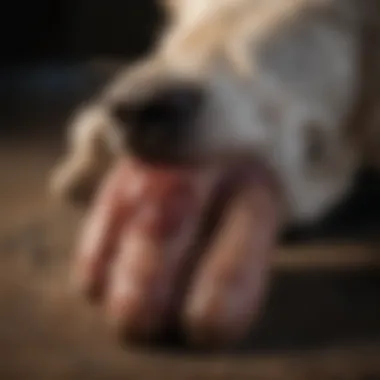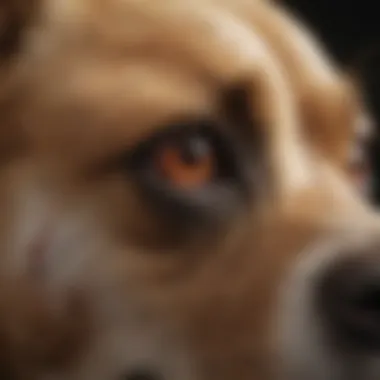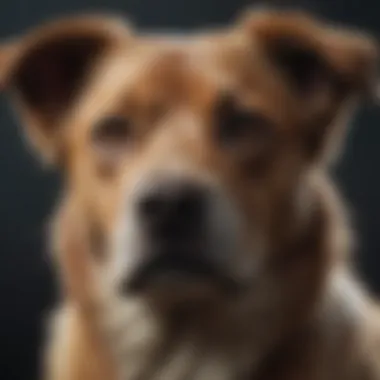A Comprehensive Guide to Treating an Infected Cut on Your Dog


Animal Species Profile
Dogs are domesticated mammals belonging to the Canidae family. They vary widely in size, shape, coat color, and temperament due to the diverse breeds available. These loyal companions have been by humans' sides for thousands of years, showcasing their versatility in roles from working animals to cherished pets.
Known for their keen sense of smell, hearing, and loyal nature, dogs have proven to be invaluable partners to humans. Whether assisting in search and rescue missions, providing emotional support as therapy animals, or being trusted guards, dogs have established themselves as crucial companions in our lives.
From fluffy Pomeranians to sturdy German Shepherds, dogs come in an array of breeds, each with unique physical characteristics and behavior traits. Understanding these differences aids in tailored care based on breed-specific needs.
When it comes to social interactions, dogs exhibit a wide range of behaviors. From playing fetch eagerly to curling up at their owner's feet, dogs showcase their affection and loyalty through various gestures. Their ability to form strong bonds with both humans and fellow canines enhances their reputation as 'man’s best friend'.
Pet Care & Tips
Caring for a dog involves more than just food and exercise; it entails a deep understanding of their physical and emotional needs. Choosing the right pet to match your lifestyle is crucial, ensuring compatibility in energy levels and space requirements.
Basic care requirements include nutritious meals, regular exercise, grooming, and veterinary check-ups. Establishing a suitable habitat, whether it be a cozy bed inside or a secure yard outdoors, contributes to a dog's well-being.
Maintaining your dog's health involves preventive measures such as vaccinations, parasite control, and dental care. Monitoring their weight and addressing any unusual symptoms promptly can prevent serious health issues.
Training techniques play a pivotal role in shaping a dog's behavior. Positive reinforcement methods coupled with consistency foster good manners and strengthen the bond between pet and owner. Implementing mental stimulation through interactive toys and activities prevents boredom and encourages cognitive development.
Introduction
In the realm of pet care, understanding and addressing an infected cut on your furry friend is of paramount importance. Our four-legged companions are not always able to communicate discomfort or distress, making it vital for pet owners to be vigilant when it comes to potential health issues. This article serves as a comprehensive guide to recognizing, treating, and preventing infections in wounds of dogs. By shedding light on crucial aspects of wound care, pet owners can ensure the well-being and health of their canine companions.
Overview of the Situation


When it comes to cuts on dogs, the situation can sometimes take a turn for the worse if not managed appropriately. Dogs, in their playful demeanor, can often encounter sharp objects or get into scuffles that result in cuts or wounds. These injuries, if left unattended, can become breeding grounds for infections, posing a threat to your pet's health. Recognizing the signs of infection and understanding the implications of untreated cuts are essential for responsible pet ownership.
Importance of Timely Intervention
Timely intervention in the case of an infected cut on your dog can make a significant difference in the healing process. Delayed treatment can lead to complications such as abscess formation, spreading of infection, and prolonged discomfort for your pet. By addressing the issue promptly, pet owners can prevent further escalation of the infection, reducing the need for aggressive medical interventions. It is crucial to act swiftly at the first signs of an infected cut to ensure a speedy recovery for your canine companion.
Link Between Cuts and Infections
The link between cuts and infections in dogs is a critical one that pet owners should be mindful of. A seemingly harmless cut, if not properly cleaned and tended to, can serve as an entry point for bacteria and other pathogens, leading to infections. Additionally, dogs may exacerbate the wound through licking or scratching, further complicating the healing process. Understanding how cuts pave the way for infections underscores the importance of proactive wound care and emphasizes the need for preventive measures to safeguard your pet's health.
Identifying an Infected Cut
In this detailed guide on addressing an infected cut on your canine companion, the segment focusing on identifying an infected cut assumes paramount importance. By discerning the signs of infection promptly, pet owners can take proactive measures to safeguard their dog's well-being effectively. The ability to spot early symptoms of infection can significantly impact the course of treatment and the overall outcome.
Signs and Symptoms to Look For
Recognizing the signs and symptoms of an infected cut on your dog is a crucial aspect of responsible pet ownership. Watch out for redness, swelling, warmth around the wound, discharge with a foul odor, and behavioral changes in your furry friend. These indicators can help you catch infection early and seek timely veterinary assistance.
Distinguishing Normal Healing from Infection
Distinguishing between normal wound healing and infection is essential for pet owners. While some degree of redness and swelling is expected during the initial stages of healing, prolonged or excessive inflammation, coupled with discharge and a bad smell around the wound, are red flags indicating infection. Understanding these nuances can aid in timely intervention and prevent complications.
Importance of Veterinary Consultation
Seeking veterinary consultation at the first sign of an infected cut is critical for your dog's health. Veterinarians possess the expertise to accurately diagnose the extent of infection, prescribe appropriate treatment, such as antibiotics or wound care products, and provide valuable guidance on caring for your pet's wound at home. Their professional insight is invaluable in ensuring a speedy and successful recovery for your beloved canine companion.


Treatment and Care
In the comprehensive guide about understanding and addressing an infected cut on a dog, the aspect of Treatment and Care plays a pivotal role. This section delves into the crucial steps and considerations necessary for the proper healing of the wound and ensuring the well-being of the dog. Treatment and Care encompass various elements, including first aid measures, medication, and follow-up protocols, as well as preventive measures to mitigate the risk of future infections. By providing detailed insights into Treatment and Care, this article equips pet owners with the knowledge to handle such situations effectively and safeguard their furry companions.
First Aid Measures
Within the realm of Treatment and Care, First Aid Measures are instrumental in kickstarting the healing process for an infected cut on a dog. The first subcategory under First Aid Measures is Cleaning the Wound. It involves meticulously cleansing the affected area to prevent further contamination and promote healing. Effective wound cleaning is crucial in preventing the spread of infection and speeding up the recovery process. Pet owners must understand the significance of this step in ensuring the wound's proper care and the dog's recovery.
Applying Antiseptic
Another vital component of First Aid Measures is Applying Antiseptic to the wound. This step involves applying antiseptic solutions to sterilize the area and reduce the risk of bacterial growth. Antiseptics play a crucial role in preventing infections and maintaining the wound's cleanliness, thereby facilitating the healing process. Understanding the importance of using suitable antiseptic agents and the correct application techniques is imperative for pet owners in managing an infected cut on their dog effectively.
Bandaging
The final aspect of First Aid Measures is Bandaging, which helps cover and protect the wound from external contaminants. Proper bandaging not only prevents dirt and debris from entering the cut but also provides support to the injured area, promoting faster healing. However, it is essential to ensure that the bandage is applied correctly to avoid restricting blood flow or causing discomfort to the dog. Pet owners must grasp the significance of bandaging as part of the overall treatment plan and employ this measure diligently for their dog's optimal recovery.
Medication and Follow-Up
In the spectrum of Treatment and Care, the administration of Medication and Follow-Up protocols is critical for addressing an infected cut on a dog. This subcategory encompasses various elements such as avoiding home remedies, the use of antibiotics, and the necessity of veterinary reevaluation. Each component plays a specific role in the treatment process, emphasizing the importance of proper medication and monitoring for the dog's swift recovery.
Avoiding Home Remedies
Firstly, Avoiding Home Remedies is essential to prevent potential complications and ensure the efficacy of the treatment. While home remedies may seem harmless, they can sometimes exacerbate the infection or delay the healing process. Opting for vet-approved treatments instead of home remedies is crucial in addressing the underlying issue and promoting the dog's well-being.
Antibiotics


The second element, Antibiotics, serves as a cornerstone in combating bacterial infections in the wound. Administering antibiotics as prescribed by the veterinarian helps eliminate harmful bacteria, reduce inflammation, and prevent the infection from spreading further. Understanding the role of antibiotics in the healing process is vital for pet owners to grasp the significance of completing the prescribed course to achieve optimal results.
Veterinary Reevaluation
Lastly, Veterinary Reevaluation plays a crucial role in monitoring the dog's progress and ensuring that the treatment plan is effective. Regular check-ups with the veterinarian allow for adjustments in medication or care instructions based on the wound's healing stage. Pet owners should prioritize veterinary reevaluation to receive expert guidance and support throughout the dog's recovery journey.
Preventive Measures
To mitigate the risk of future infections, implementing Preventive Measures is paramount in the Treatment and Care plan for an infected cut on a dog. This final subcategory covers aspects such as maintaining hygiene, avoiding irritants, and scheduling regular check-ups to prevent recurrence and promote the overall well-being of the dog.
Maintaining Hygiene
Maintaining Hygiene around the wound area is essential in preventing contamination and facilitating healing. Keeping the wound clean and dry, as well as following proper hygiene practices, minimizes the risk of secondary infections and supports the dog's recovery. Pet owners must adhere to hygiene guidelines to create an optimal environment for the wound to heal effectively.
Avoiding Irritants
Another crucial aspect is Avoiding Irritants that can exacerbate the dog's condition or impede the healing process. Common irritants such as harsh chemicals or rough fabrics should be avoided to prevent further discomfort or complications. By steering clear of potential irritants, pet owners can create a conducive environment for the wound to heal without unnecessary disruptions.
Regular Check-Ups
Lastly, scheduling Regular Check-Ups with the veterinarian is essential for monitoring the dog's overall health and addressing any potential issues proactively. Routine check-ups enable early detection of any signs of infection recurrence or delayed healing, allowing for timely interventions. Pet owners should prioritize regular veterinary visits to stay informed about their dog's recovery progress and take necessary actions to ensure a successful outcome.
Conclusion
In wrapping up our detailed guide to addressing an infected cut on your beloved dog, it is crucial to emphasize the paramount importance of early intervention and vigilant care. By being proactive in recognizing signs of infection and promptly seeking veterinary assistance, pet owners can significantly enhance the healing process and prevent complications. The significance of regular monitoring and follow-up cannot be understated, as quick action can make a profound difference in your dog's recovery and overall well-being. By following the recommended treatment and preventive measures diligently, you are not just addressing the immediate issue but also safeguarding your furry companion's health in the long run.
Importance of Proactive Care
When it comes to your dog's health, proactive care plays a pivotal role in maintaining their overall well-being. Regularly inspecting your pet for any cuts or wounds can help catch potential issues early on, preventing them from escalating into more severe conditions. Promptly addressing any injuries through proper cleaning and disinfection can aid in minimizing the risk of infections. Additionally, establishing a routine for preventive measures such as maintaining a clean living environment and providing a balanced diet can bolster your dog's immune system, reducing their susceptibility to illnesses. Taking a proactive approach to your pet's care not only ensures their physical health but also fosters a deeper bond and understanding between you and your furry companion.
Ensuring Your Dog's Well-Being
Ensuring your dog's well-being encompasses not only addressing immediate health concerns but also promoting a holistic and enriching lifestyle for your beloved pet. Beyond physical health, mental stimulation and emotional well-being are equally integral aspects of your dog's welfare. Providing ample opportunities for exercise, play, and social interaction can contribute to your dog's mental and emotional fulfillment, helping prevent stress and behavioral issues. Additionally, maintaining a consistent routine for grooming, veterinary check-ups, and vaccinations is fundamental in safeguarding your dog against potential health risks. By prioritizing your dog's overall well-being and creating a nurturing environment, you are laying a strong foundation for a long and joyful companionship with your loyal four-legged friend.







